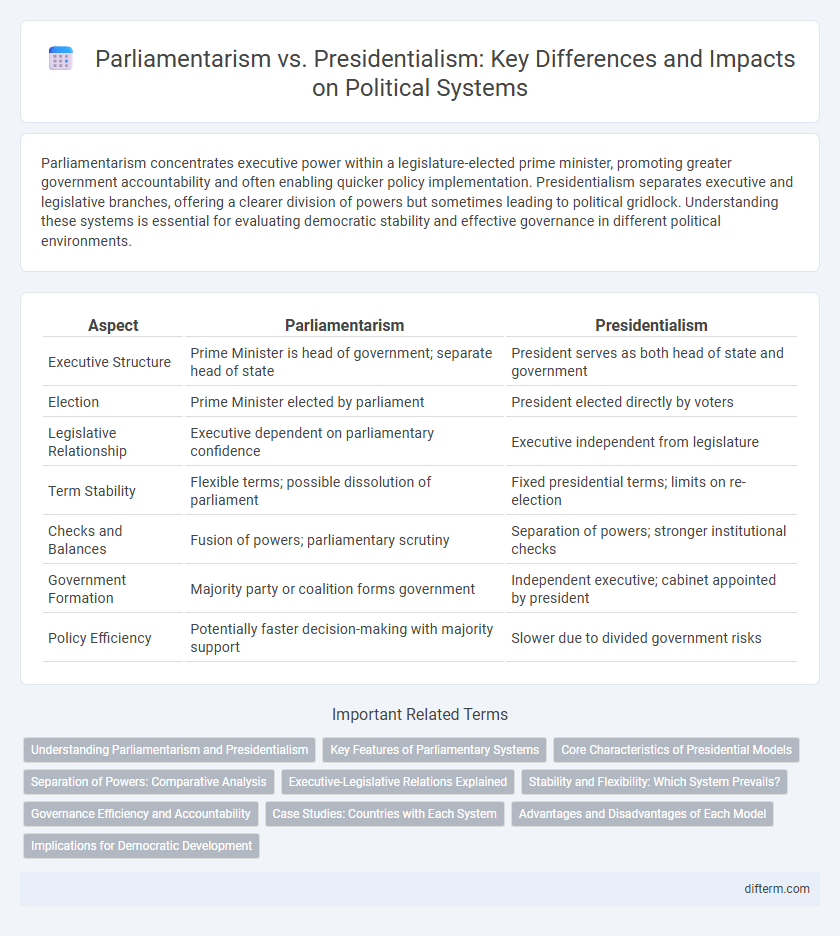Parliamentarism concentrates executive power within a legislature-elected prime minister, promoting greater government accountability and often enabling quicker policy implementation. Presidentialism separates executive and legislative branches, offering a clearer division of powers but sometimes leading to political gridlock. Understanding these systems is essential for evaluating democratic stability and effective governance in different political environments.
Table of Comparison
| Aspect | Parliamentarism | Presidentialism |
|---|---|---|
| Executive Structure | Prime Minister is head of government; separate head of state | President serves as both head of state and government |
| Election | Prime Minister elected by parliament | President elected directly by voters |
| Legislative Relationship | Executive dependent on parliamentary confidence | Executive independent from legislature |
| Term Stability | Flexible terms; possible dissolution of parliament | Fixed presidential terms; limits on re-election |
| Checks and Balances | Fusion of powers; parliamentary scrutiny | Separation of powers; stronger institutional checks |
| Government Formation | Majority party or coalition forms government | Independent executive; cabinet appointed by president |
| Policy Efficiency | Potentially faster decision-making with majority support | Slower due to divided government risks |
Understanding Parliamentarism and Presidentialism
Parliamentarism centralizes executive power within the legislature, where the prime minister and cabinet are accountable to the parliament, enabling flexible governance through votes of confidence. Presidentialism features a separate, directly elected president who serves fixed terms independent of legislative approval, fostering stability but sometimes leading to gridlock. Understanding these systems involves analyzing how executive-legislative relations impact policy-making, political accountability, and democratic responsiveness.
Key Features of Parliamentary Systems
Parliamentary systems feature a fusion of executive and legislative branches, where the government is directly accountable to the legislature and can be dismissed by a vote of no confidence. The head of state and head of government are typically separate roles, with the prime minister serving as the chief executive chosen from the legislative majority. This structure promotes greater government stability and responsiveness through frequent legislative oversight and collaboration.
Core Characteristics of Presidential Models
Presidential models feature a clearly defined separation of powers between the executive and legislative branches, with the president serving as both head of state and government. The president is directly elected by the populace, holding fixed terms and substantial authority over policy implementation and administration. Unlike parliamentary systems, presidentialism emphasizes stability through fixed terms but may face challenges with divided government and legislative-executive gridlock.
Separation of Powers: Comparative Analysis
Parliamentarism features a fusion of executive and legislative powers, where the executive branch is derived from and accountable to the legislature, promoting closer cooperation and more flexible government formation. Presidentialism maintains a strict separation of powers, with independently elected executives and legislatures to prevent concentration of authority and encourage checks and balances. Studies indicate that parliamentary systems often enable quicker policy responses, while presidential systems emphasize stability and institutional autonomy.
Executive-Legislative Relations Explained
Parliamentarism features a close integration between the executive and legislature, where the prime minister and cabinet depend on parliamentary confidence to govern, enabling swift policy implementation and accountability. In presidentialism, the executive and legislature are separately elected, creating potential for divided government that can lead to gridlock but also provides checks and balances against executive overreach. Executive-legislative relations in parliamentarism are characterized by collaborative policymaking, while presidentialism emphasizes separation of powers and institutional independence.
Stability and Flexibility: Which System Prevails?
Parliamentarism offers greater flexibility in government formation and dissolution, allowing swift responses to political shifts through votes of no confidence and coalition adjustments, enhancing adaptability during crises. Presidentialism provides stability via fixed terms and separation of powers, preventing abrupt leadership changes but sometimes leading to gridlock when executive and legislature conflict. Stability favors presidentialism's fixed mandates, while flexibility aligns with parliamentarism's responsive mechanisms, impacting governance effectiveness in diverse political environments.
Governance Efficiency and Accountability
Parliamentarism enhances governance efficiency by enabling faster legislative processes through majority party control, reducing gridlock often seen in presidential systems. Accountability is strengthened as the executive is directly answerable to the parliament, allowing for swift removal via votes of no confidence. In contrast, presidentialism may face slower policy implementation and divided government, but provides clearer separation of powers that can prevent authoritarianism.
Case Studies: Countries with Each System
Countries like the United Kingdom and Canada exemplify parliamentarism, where the executive derives its legitimacy from the legislative branch and is accountable to it, fostering cooperation and flexibility in governance. In contrast, the United States and Brazil illustrate presidentialism, with a distinct separation of powers between the executive and legislature, promoting checks and balances but potentially leading to gridlock. Case studies highlight that parliamentary systems often enable more efficient policy-making, while presidential systems emphasize stability and direct voter mandates for the executive.
Advantages and Disadvantages of Each Model
Parliamentarism offers greater flexibility in government formation and can lead to more stable policy implementation through coalition-building, but it risks frequent government changes and weaker separation of powers. Presidentialism provides a clear separation of executive and legislative branches, which can enhance checks and balances and avoid parliamentary deadlocks, though it may cause gridlock and limit executive accountability. Both systems impact political stability and governance efficiency differently, influencing democratic consolidation and responsiveness.
Implications for Democratic Development
Parliamentarism often fosters greater political stability and accountability by enabling efficient legislative-executive collaboration and easier removal of ineffective leaders through votes of no confidence. Presidentialism, with its fixed terms and separation of powers, can prevent authoritarianism but may lead to gridlock and weaken responsiveness to popular demands. The choice between these systems significantly shapes democratic consolidation, influencing governance quality, citizen trust, and institutional checks and balances.
parliamentarism vs presidentialism Infographic

 difterm.com
difterm.com